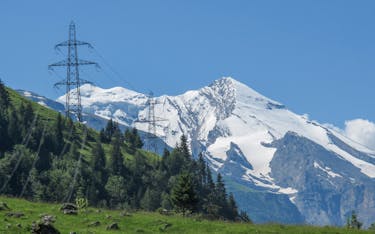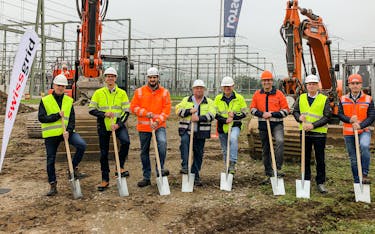People & environment
The environmental compatibility report is from 2008. The authors come to the conclusion that any significant risk to the environment can be excluded. The southern line connection will ease the burden on Rüthi's industrial zone and the village of Rehag. According to the report the effects on the environment are limited and no significant additional burden can be detected – even on the BLN (protected landscape) area. It states that the project is legally compliant.
Landscape
The line crosses a countryside conservation area in the region of Blattenberg. One section lies in the «Säntisgebiet» protected landscape area. As a result of landscape-protection considerations, the pylons will be kept low in the hilly region, which will require the partial height restriction of the forest. An attempt has also been made to select the locations of the pylons in such a way that they slot into the landscape as inconspicuously as possible. The pylons will be coloured in such a way that they match the predominant background colour.
The tension string sets of the substation for the western, northern and eastern line connections are 17.5 metres high, while those for the connection from the south are 30 metres high because these are already designed for the future upgrade to 380 kV. The substation will be adapted to its surroundings by means of suitable colours for the tension string sets and the busbars, as well as for the service building. In addition, there will be natural landscaping with hedges and lines of trees to achieve good integration into the surrounding scenery.
Electromagnetic fields
Within the study perimeter according to the Non-Ionising Radiation Ordinance (NISV), there are 2 buildings with locations with sensitive use (OMENs), in which the system limit value of 1 microtesla must be complied with. As the line crosses the valley at a height of around 100 metres at that point, compliance with all the NISV regulations is fully achieved. There is also full compliance with the NISV where the substation is concerned.
Noise / air
The line connections will for the most part affect areas of forestry and agriculture, and not built-up or residential zones. Calculations relating to corona noise show that this will be significantly below the prescribed planning value of 50 dB(A). The regulations from the Noise-Protection Ordinance (LSV) will be fully complied with.
As there is no provision for a transformer in the first phase, the planned 220 kV switching substation will in principle create no noise when in operation. The only exceptions to this will be occasionally audible switching procedures. The nearest building with noise-sensitive rooms is over 250 metres away from the substation. Consequently there will also be full compliance with the LSV with regard to the substation.
Noise emissions during the construction phase will be intermittent and limited to a relatively short duration – including for the scheduled use of a helicopter for construction and installation work. Low-noise procedures will be employed during the construction work and the quiet periods will be adhered to.
Low-emission tools and machinery will be used to reduce air pollution.
Forest
There will be a total of 4 pylons in forest areas. Both temporary and permanent clearings will be necessary for the foundation structures, for material and assembly storage facilities and for any future maintenance work. The definitive area to be cleared is 1085 sq m. Temporary clearings amounting to 1573 sq m will be necessary for the storage of materials and for turning vehicles.
The temporary clearings will be made good in situ after removal of the installation sites and access roads. The definitive clearings (1085 sq m) will be replaced in the locality of Montlingen.
This relates particularly to the as yet unapproved northern connection. So there may still be changes in this case if an underground cable has to be built or if an alternative overhead line route has to be found.
Fauna
The risk to birds of electrocution is low with 380 and 220 kV overhead lines. On the other hand the risk of collision is relatively high, especially for the owls and hobbies to be found in this region. Local protection measures will be checked should any problems arise. It is very unlikely that there will be any striking deterioration of the birds' habitats in the already polluted area.
As a result of the wildlife to be found in the forest on the Blattenberg, construction work in this region should not extend into the winter months to minimise disruption during the construction period. To ensure that the wildlife corridor from Meiningen across the Rhine into the region of the Blattenberg is not restricted in its function, a 30-metre corridor will be left clear between the substation fence and the forest. and upgraded with structures.
No effects are to be expected on any amphibians, reptiles or fish.
Vegetation, soil and water
The project does not impinge on any moors or bogs, rough pasture or other protected areas of national importance. Other habitats worthy of protection are to be retained and restored. In the event of any lasting adverse effects, compensatory measures will be carried out.
When excavating the Swissgrid and SBB substations, large quantities of valuable soil will be accumulated. This unpolluted material is not to be disposed of at a waste tip, taking up valuable landfill capacity, but is to be reused in the municipality of Rüthi. In this context priority will be given to the restoration of subsidence caused by construction in the «Werben» and «Stöcken» districts, as well as the replacement of heavily polluted material associated with the clean-up of the former landfill site at «Sand». With these soil improvements, the soil quality can be improved in these districts and agricultural usage can be simplified. The removal of soil on the construction site and the intended soil improvement work will only be carried out in good ground and weather conditions and under the supervision of a soil scientist, guaranteeing that they are carried out in an appropriate manner.
No pylons will be erected in the immediate vicinity of surface water, whereas 6 pylons and the entire substation will be in the water pollution control area. The maximum depth of the foundations for the substation, including service building, tension string sets and busbars, will be 2.5 metres. For that reason great care should be taken during the construction work to ensure that the groundwater is not polluted. The water pollution control measures in the area of the substation will be defined together with the environmental construction supervisors.
Compensation measures
- Removal of the existing 220-kilovolt overhead line over a length of 1.8 kilometres (5 pylons) through the Rüthi industrial zone and the hamlet of Rehag
- For the impact on the forest (definitive clearance area), effective compensatory measures will be carried out in the locality of Montlingen
- Enhancement of the oak forests in Schlatt
- The country area near the inland canal has been ecologically restored. This is a local recreation area for the population.






